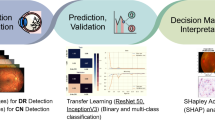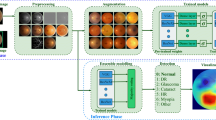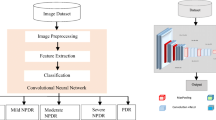Abstract
An eye disease that damages the retina of diabetic patients is known as diabetic retinopathy (DR). The severity of the disease is found by different lesions such as hemorrhages, microaneurysms, exudates etc., these are the early stage symptoms of non-proliferative DR for early analysis of DR. A single framework for instinctive Lesion Detection used for diagnosis of the disease easily by screening is proposed. It consists of four steps: luminosity and contrast enhancement, removal of extracted blood vessels and optic disc (OD), lesion detection and classification based on lesions. Gamma correction and CLAHE for luminosity and contrast enhancement. Principle component analysis for vessel extraction and using convex hull transform for OD detection. After background subtraction, lesions are detected using morphological operations and classification based on count of lesions. The proposed algorithm is analyzed using the publically available datasets and evaluated using the metrics of specificity, sensitivity and accuracy.













Similar content being viewed by others
Change history
04 July 2022
This article has been retracted. Please see the Retraction Notice for more detail: https://doi.org/10.1007/s12652-022-04256-3
References
Agurto C et al (2014) A multiscale optimization approach to detect exudates in the macula. IEEE J Biomed Health Inform 18(4):1328–1336
Akram MU et al (2014a) Detection and classification of retinal lesions for grading of diabetic retinopathy. Comput Biol Med 45:161–171
Akram MU, Khalid S, Tariq A, Khan SA, Azam F (2014b) Detection and classification of retinal lesions for grading of diabetic retinopathy. Comput Biol Med 45:161–171
Annunziata R, Garzelli A, Ballerin L, Mecocci A, Trucco E (2016) Leveraging multiscale hessian-based enhancement with a novel exudate inpainting technique for retinal vessel segmentation. IEEE J Biomed Health Inform 20(4):1129–1138
Balasubramanian K, Ananthamoorthy NP (2019) Robust retinal blood vessel segmentation using convolutional neural network and support vector machine. J Ambient Intell Hum Comput. https://doi.org/10.1007/s12652-019-01559-w
Dashtbozorg B, Zhang J, Huang F, ter Haar Romeny BM (2018) Retinal microaneurysms detection using local convergence index features. IEEE Trans Image Process 27(7):3300–3315
Esmaeili M, Rabbani H, Dehnavi AM, Dehghani A (2012) Automatic detection of exudates and optic disk in retinal images using curvelet transform. IET Image Process 6(7):1005–1013. https://doi.org/10.1049/iet-ipr.2011.0333
Fleming AD, Philip S, Goatman KA, Olson JA, Sharp PF (2006) Automated micro aneurysm detection using local contrast normalization and local vessel detection. IEEE Trans Med Imaging 25(9):1223–1232
Gadkari SS, Maskati QB, Nayak BK (2016) Prevalence of diabetic retinopathy in India: the all India ophthalmological society diabetic retinopathy eye screening study. Indian J Ophthalmol 64:38–44
Hoover A et al (2000) Locating blood vessels in retinal images by piece-wise threshold probing of a matched filter response. IEEE Trans Med Imaging 19(3):203–210
Huang S-C, Cheng F-C, Chiu Y-S (2013) Efficient contrast enhancement using adaptive gamma correction with weighting distribution. IEEE Trans Image Process 22(3):1032–1041
Iqbal MI, Gubbal NS, Aibinu AM, Khan A (2006) Automatic diagnosis of diabetic retinopathy using fundus images’. Masters thesis, Blekinge Institute of Technology
Kalesnykiene V et al (2007) Diaretdb1 diabetic retinopathy database and evaluation protocol [online]. https://www.it.lut.fi/project/imageret/diaretdb1. Accessed 9 Apr 2018
Kar SS, Maity SP (2018) Automatic detection of retinal lesions for screening of diabetic retinopathy. IEEE Trans Biomed Eng 65(3):608–618
Li H, Chutatape O (2004) Automated feature extraction in color retinal images by a model based approach. IEEE Trans Biomed Eng 51(2):246–254
Li T, Gao Y, Wang K, Guo S, Liu H, Kang H (2019) Diagnostic assessment of deep learning algorithms for diabetic retinopathy screening. Inf Sci. https://doi.org/10.1016/j.ins.2019.06.011
Mansoor AB, Khan Z, Khan A, Khan SA (2008) Enhancement of exudates for the diagnosis of diabetic retinopathy using fuzzy morphology. In: 2008 IEEE International Multitopic Conference. https://doi.org/10.1109/INMIC.2008.4777722
Messidor (2008) [Online]. https://www.messidor.crihan.fr/indexen.php. Accessed 9 Apr 2018
Mudrova M, Prochazka A (2005) Principal component analysis in image processing. In: Proceedings of the MATLAB technical computing conference, Prague
Niemeijer M et al (2004) DRIVE: digital retinal images for vessel extraction [online]. https://www.isi.uu.nl/Research/Databases/DRIVE. Accessed 9 Apr 2018
Niemeijer M et al (2010) Retinopathy online challenge: automatic detection of microaneurysms in digital color fundus photographs. IEEE Trans Med Imaging 29(1):185–195
Osareh A, Shadgar B, Markham R (2009) A Computational-intelligence-based approach for detection of exudates in diabetic retinopathy images. IEEE Trans Inf Technol Biomed 13(4):535–545
Quellec G et al (2008) Optimal wavelet transform for the detection of microaneurysms in retina photographs. IEEE Trans Med Imaging 27(9):1230–1241
Sahu D, Meshram S (2016) Automatic detection of hemorrhages using image processing technique. Int J Eng Sci Res Technol 5:853–857
Sopharak A, Uyyanonvara B, Barmanb S, Williamson TH (2008) Automatic detection of diabetic retinopathy exudates from non- dilated retinal images using mathematical morphology methods. Comput Med Imaging Gr 32:720–727
Ullaha H, Islam N, Jan Z et al (2018) Optic disc segmentation and classification in color fundus images: a resource-aware healthcare service in smart cities. J Ambient Intell Hum Comput. https://doi.org/10.1007/s12652-018-0988-8
Valarmathi R, Saravanan S (2019) Exudate characterization to diagnose diabetic retinopathy using generalized method. J Ambient Intell Hum Comput. https://doi.org/10.1007/s12652-019-01617-3
Walter T et al (2002) A contribution of image processing to the diagnosis of diabetic retinopathy—detection of exudates in color fundus images of the human retina. IEEE Trans Med Imaging 21(10):1236–1243
Yau JWY et al (2012) Global prevalence and major risk factors of diabetic retinopathy. Diabetes Care 35(3):556–564
Zhou W, Wu C, Yi Y, Du W (2017a) Automatic detection of exudates in digital color fundus images using superpixel multi-feature classification. IEEE Access 5:17077–17088
Zhou W, Wu C, Chen D, Wang Z, Yi Y, Du W (2017b) A novel approach for red lesions detection using superpixel multi-feature classification in color fundus images. In: 2017 29th Chinese Control And Decision Conference (CCDC), IEEE, Chongqing, pp. 6643–6648. https://doi.org/10.1109/CCDC.2017.7978371
Zhou M, Jin K, Wang S, Ye J, Qian D (2018) Color retinal image enhancement based on luminosity and contrast adjustment. IEEE Trans Biomed Eng 65(3):521–527. https://doi.org/10.1109/TBME.2017.2700627
Author information
Authors and Affiliations
Corresponding author
Additional information
Publisher's Note
Springer Nature remains neutral with regard to jurisdictional claims in published maps and institutional affiliations.
This article has been retracted. Please see the retraction notice for more detail: https://doi.org/10.1007/s12652-022-04256-3
About this article
Cite this article
Kanimozhi, J., Vasuki, P. & Roomi, S.M.M. RETRACTED ARTICLE: Fundus image lesion detection algorithm for diabetic retinopathy screening. J Ambient Intell Human Comput 12, 7407–7416 (2021). https://doi.org/10.1007/s12652-020-02417-w
Received:
Accepted:
Published:
Issue Date:
DOI: https://doi.org/10.1007/s12652-020-02417-w




